

|
All Photographs © Sam Oppenheim
|
|||||||||||||
| ||||||||||||||
| |||||||||||||||||

By Sam Oppenheim So I decided to re-visit the source of the Ganges. Traveling with Shekhar made the bumpy crowded shared jeep more comfortable. From Uttarkashi we found transportation to Gangotri and then hiked the 14 kilometers to Bhojbhasa, retracing my footsteps I had made a month before with Edwin. (See travelogue 10)  The snow had all melted, but the same path was as memorable as a childhood hometown, changed with time but unmistakable. Subtle differences were overshadowed by the complete lack of snow and vivid swath of green carpeting everything. It was like a painter had touched up my memory with color where before there was only black and white, snow and rock. Huge 1 foot long lizards had come out of hibernation and were sunning themselves where previously I had slipped on a snowbank. Ants were moving laboriously, building a nest on soil that was hidden under a foot of snow. The valley had come alive and bare trees had grown all their leaves back for my return. This time the hike to Bhojbhasa took only 5 hours instead of a day and a half. This time there were other pilgrims on the trail and we were not alone. The government road builders had even repaired all the dangerous places where the snow and melt had torn the trail away from the mountainside. Donkeys were able to traverse what had one month previously been a sheer wall of ice.
The snow had all melted, but the same path was as memorable as a childhood hometown, changed with time but unmistakable. Subtle differences were overshadowed by the complete lack of snow and vivid swath of green carpeting everything. It was like a painter had touched up my memory with color where before there was only black and white, snow and rock. Huge 1 foot long lizards had come out of hibernation and were sunning themselves where previously I had slipped on a snowbank. Ants were moving laboriously, building a nest on soil that was hidden under a foot of snow. The valley had come alive and bare trees had grown all their leaves back for my return. This time the hike to Bhojbhasa took only 5 hours instead of a day and a half. This time there were other pilgrims on the trail and we were not alone. The government road builders had even repaired all the dangerous places where the snow and melt had torn the trail away from the mountainside. Donkeys were able to traverse what had one month previously been a sheer wall of ice.
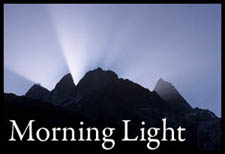 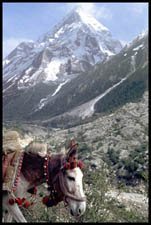 This time it was possible to hike beyond Bhojbhasa. On the second day Shekhar and I hiked to Gaumukh: the 'cow's face'. This is the glacier which is the source of the Ganges river and is receding at the amazing rate of 20-30 feet a year due to global warming. The hike to it began easy, but eventually we found ourselves traversing terrain straight out of a post-apocalyptic sci-fi movie. The last kilometer was spent clamoring over rocks and silt in a cold desert created by the fast retreat of a glacier. The landscape is known as a 'Glacial Moraine' and it is as beautiful as it is alien: crowned in the distance by a sheer wall of bluish ice, cracked like an accordion, moving in geological time, expanding and contracting, shedding outer layers like a sliced cheese. Sometimes the glacier dangerously explodes when a million-year old air pocket expands in heat and shreds ice splinters, which are spit across the valley in front of the glacier. 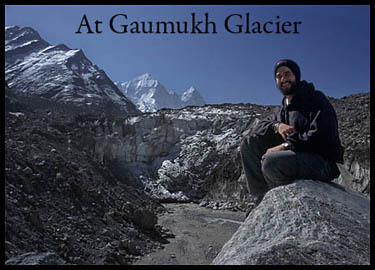 We meditated nearby, (but not too near, people are killed each year by falling ice) and even did yoga asanas on a flat rock within view of the massive glacier. Pilgrims, some extremely devoted to the Ganga pilgrimage, bathed themselves in the 4 degrees Celsius water flowing out from under the mouth of the glacier. Although the glacier is the source of the Ganges, in reality, this water is an underground river flowing beneath the glacier which is fed by snow and ice melt from the whole mountain region above the glacier. The trail runs further and as it was early and we wanted to go as high as we could again, next we climbed upon the glacier.
We meditated nearby, (but not too near, people are killed each year by falling ice) and even did yoga asanas on a flat rock within view of the massive glacier. Pilgrims, some extremely devoted to the Ganga pilgrimage, bathed themselves in the 4 degrees Celsius water flowing out from under the mouth of the glacier. Although the glacier is the source of the Ganges, in reality, this water is an underground river flowing beneath the glacier which is fed by snow and ice melt from the whole mountain region above the glacier. The trail runs further and as it was early and we wanted to go as high as we could again, next we climbed upon the glacier.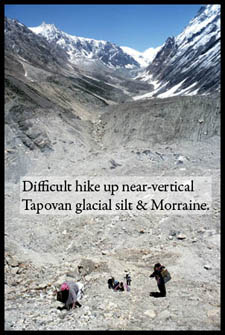 The path follows the relatively safe dirty left wall of the glacier, we found ourselves facing walls of blackish ice, ominously melting slowly with little rocks and dirt moving down its walls like it was a slimy beast, alive and drooling. Then once upon its top we safely walked across the back of the glacier, hardly aware that beneath a veneer of dirt and rock was million-year-old ice, slowly moving.
The path follows the relatively safe dirty left wall of the glacier, we found ourselves facing walls of blackish ice, ominously melting slowly with little rocks and dirt moving down its walls like it was a slimy beast, alive and drooling. Then once upon its top we safely walked across the back of the glacier, hardly aware that beneath a veneer of dirt and rock was million-year-old ice, slowly moving.The most difficult climb I have ever done was that afternoon when we went up a steep face of a waterfall. The glacial silt that was the walls' main foundation is so fine it blows into your eyes in the wind, and shifts under every footstep. Rocks came down all around you as you climbed up, although amazingly nobody got hurt and one old woman and old man climbed up it on all fours with looks of crazed anguish on their face. I hoped they would turn around to safety. But with determination unlike that I normally witness they scaled the waterfall behind me and I greeted them from the top. Actually above Gaumukh there is not much to see besides dirt and rocks. After the monsoon the region blooms with seasonal rare flowers and herbs, but now after winter and a month before the monsoon, it was a cold rocky desert with a river flowing over it and into a waterfall disappearing beneath the shifting sands and into the belly of the glacier to form the Ganges. Luckily we encountered a nice sadhu who lives in silence upon the glacier in this region, Tapovan. Tapovan means 'place of Tapas' (austerities) and therefore he was following the tradition of meditation and austerities performed living on top of a glacier. Shekhar was exhausted, unwilling to go farther, and ate chapattis and drank warm water made by the sadhu, while I ate two chapattis and climbed alone up a further rocky cliff to explore Ghandarvan: 'the abode of heavenly beings' an aquamarine mountain lake above Tapovan. 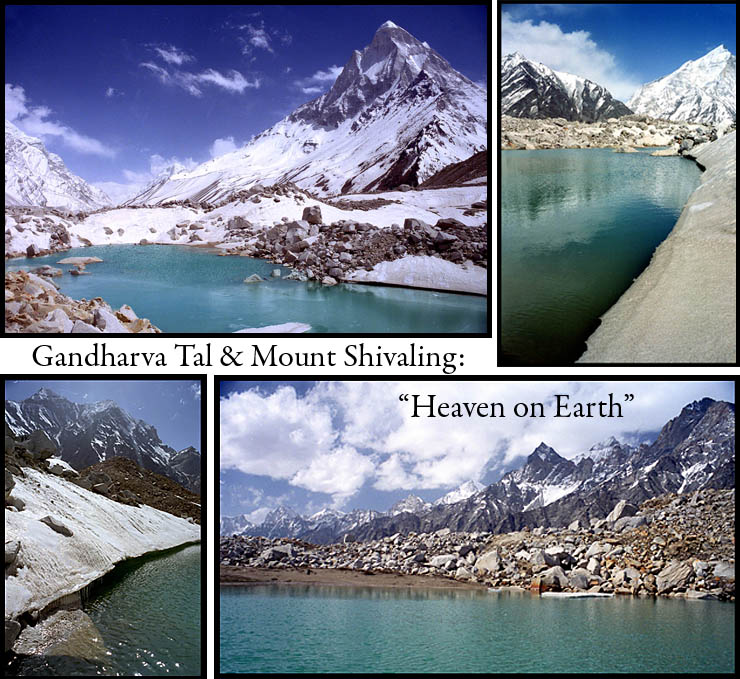 Once there I was amazed in silence, photographing and spiritually soaking it all up. I was alone in a dreamlike landscape of snow, ice, rock, mountain peaks all around me, and in the center, a small pristine, clear, turquoise lake. My photographs have been developed and they do not quite do justice to the region but they reveal its heavenly nature. I was so lucky to have spent one of my last afternoons in India in this area. I meditated there, alone, in only my underwear, surrounded by ice and snow, but warmed by inner fire and the strong mountain sun.
Once there I was amazed in silence, photographing and spiritually soaking it all up. I was alone in a dreamlike landscape of snow, ice, rock, mountain peaks all around me, and in the center, a small pristine, clear, turquoise lake. My photographs have been developed and they do not quite do justice to the region but they reveal its heavenly nature. I was so lucky to have spent one of my last afternoons in India in this area. I meditated there, alone, in only my underwear, surrounded by ice and snow, but warmed by inner fire and the strong mountain sun.After those two mountain pilgrimages and experiences which I cannot quite express in words, what could I do with my last days in India? I had to re-enter the world of man and leave the world of god. I had to spend nearly three days continuously traveling to make it to Delhi for my flight to London. I had the good fortune of traveling with Shekhar, we discussed what we had left behind and made plans to return in one year, perhaps with supplies and a tent to meditate in silence for a week in the place where I truly felt like a guest of god, no longer surrounded by all that makes me sick of the world, no longer distracted by money, men, women, and all the normal human urges. I wasn't hungry, tired, or really even very much myself, I was elevated up there to a sense of being I only wish I could feel all the time. Coming back to Rishikesh and Mussoorie on my way to a train to Delhi was odd. First I ate a delicious meal at Mukti's my favorite restaurant, and in an amazing coincidence sat down across from a familar face: We began talking and discovered we knew each other from Columbia University, he was Matt, Vipin's roommate from freshman year - also seeking spirituality in India. Then being in Mussoorie was awkward, I wanted to say goodbye to all my old friends, but I also felt like an outsider, for I had already said goodbye a month before. I felt ghostly, passing though a place I had called home, on my way to another place to explore in Europe, but part of me remained in the mountains, and none of me was certain where I really was. 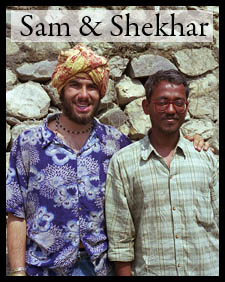 Today my sense of what occurred in India is already getting more distant, I am in a daze of technology and humanity: London Gatwick Airport. Paying for email surrounded with the sounds of cash registers, TV's, Radios, people in high heels, and flat screen computer monitors. This is all so alien, yet so familiar. I almost feel schizophrenic, able to glimpse and remember the TRUE me in the mountains - yet able to be the 'Sam' I had built and experienced in society, conditioned to act appropriately, and function in modern society.
Today my sense of what occurred in India is already getting more distant, I am in a daze of technology and humanity: London Gatwick Airport. Paying for email surrounded with the sounds of cash registers, TV's, Radios, people in high heels, and flat screen computer monitors. This is all so alien, yet so familiar. I almost feel schizophrenic, able to glimpse and remember the TRUE me in the mountains - yet able to be the 'Sam' I had built and experienced in society, conditioned to act appropriately, and function in modern society.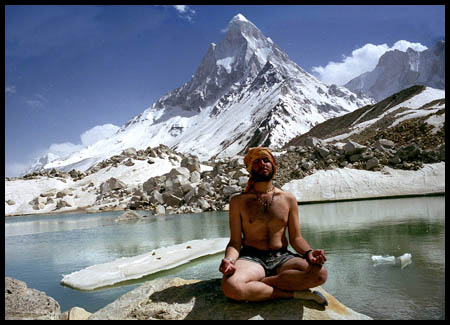 The experience of entering India and slowing acculturating myself took 5 months. I learned to eat with my hands and live simply, speak Hindi, and be comfortable in a different way than western 'comfort'. Finally at the peak of this experience I reached heights of mind, self exploration, spirituality, and god's pure nature. Coming to Europe is like coming down from a drug experience, I feel 'normal' now and 'comfortable' here but I felt 'better' beforehand, the question I have to evaluate is if the experiences of India can be replicated and brought into my 'normal' life to enrich it, or whether a normal modern life precludes the closeness to god and nature that I was able to find by altering my surroundings and lifestyle for 5 months.
The experience of entering India and slowing acculturating myself took 5 months. I learned to eat with my hands and live simply, speak Hindi, and be comfortable in a different way than western 'comfort'. Finally at the peak of this experience I reached heights of mind, self exploration, spirituality, and god's pure nature. Coming to Europe is like coming down from a drug experience, I feel 'normal' now and 'comfortable' here but I felt 'better' beforehand, the question I have to evaluate is if the experiences of India can be replicated and brought into my 'normal' life to enrich it, or whether a normal modern life precludes the closeness to god and nature that I was able to find by altering my surroundings and lifestyle for 5 months.If my prediction holds true my next travelogue will be more normative and less interesting. I may really enjoy myself in Spain, but it won't be comparable to the different states of awareness I found in the Himalayas of India. Perhaps I will find time to climb a mountain and experience my inner nature again, or perhaps once I return to Starbucks and Silverware at every meal I will have distanced myself from my own nature too much to escape with just a few days in nature. I imagine it might require at least two weeks away from culture to finally feel free of all the bonds and restrictions modernity and society places on your self. It seems to reinforce your sense of ego, rather than helping you to escape it like living in India, or in nature does. Note: all the photos did not fit - here's some more! |